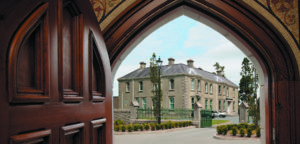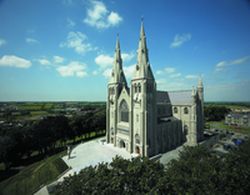CHRISTMAS VIGIL MASS
HOMILY GIVEN BY
CARDINAL SEÁN BRADY
IN
ST. PATRICK’S CATHEDRAL, ARMAGH
Recently a well-known American singer/songwriter was interviewed on radio. The interviewer noted that all her songs were love songs. “Have you known love”? he asked. “I’ve known heartbreak” was her reply. How true. Sometimes to know heartbreak is to know love – and to know the pain of love is to know its depth and its price.
Christmas speaks to us of love. The love of God for us. “For God so loved the world that he gave us his only son” (John 3:16). The child in the manger speaks of the depths of God’s love, of the self-giving of God, of the emptying of God to become human. “His state was divine…He emptied himself to become as humans are, taking on the condition of a slave, and he was humbler yet” (Phil 2:6). The wood of that manger would one day be exchanged for the wood of the cross, the price of love.
This is the agony and the ecstasy of Christmas, the depth of love and its price conveyed in the simple beauty of the characters and in the simplicity of Jesus, Mary and Joseph in the Christmas story.
It is a reminder that Christmas is not a happy time for everyone – that, precisely because of love, it can also be a time of loss, or feeling out of tune with the celebrations and the season.
This Christmas I am conscious of the many people who know the ecstasy and joy of Christmas in their celebration of new births in the family, new marriages begun, fortunes made and won, new jobs secured and qualifications achieved.
I am also conscious of those who know its pain. The families left bereaved through accidents on our roads, through the abuse of alcohol, cocaine and the cocktails of other drugs which sully our streets. I am conscious of the parents separated from their children because of migration or deportation. I am conscious of the number of homeless people for whom Christmas is about surviving in the cold while others are carried along by its warmth.
Christmas also speaks to us of wonder – the kind of wonder that leads to the adoration and joy that are at the heart of Christmas. “Ah, Christmas is only for children” the cynic says. Yes and No. We all need the eyes of a child so that we are amazed and made to wonder at what we hear tonight.
The genius of St. Francis and the Christmas crib is that in its simplicity, it captures the mystery of Christ. It creates the wonder that is calling us to say: “Come let us adore Him”. Only those with eyes to see the adorable one are actually able to adore.
The joy of Christmas is real but it is not superficial. The angels announced news of “great joy” “ a joy to be shared by the whole people” (Lk 2:10). That is why, when we have enjoyed our joy, the real Christmas begins. That work is captured in the Christmas poem of Howard Thurman:
When the song of the angels is stilled,
When the star in the sky is gone,
When the kings and the princes are home,
When the shepherds are back with their flock,
The work of Christmas begins:
To find the lost
To heal the broken
To feed the hungry
To release the prisoner
To rebuild the nations
To bring peace among others
To make music in the heart.
Whether Christmas is for you a time of ecstasy or pain, I pray that because God is with us in the child of Bethlehem, it will be a time when we will all know music in our heart.
Jesus came to lead humankind from exile into the kingdom of Heaven. In other words, he came to lead all of us out of exile to our real home in Heaven. That is probably the reason why we all love to be at home for Christmas. I welcome those who have come home to Armagh this Christmas.
But what or where is home?
· Home is where those we love live.
· Home is where the most beautiful and important things happen to us.
· Home is where we hear the truth about ourselves, whether we want to listen to it or not is another thing.
· Home is where we are accepted and understood and loved just as we are.
Our best memories are of home and the good things that take place there. Where gifts are given and accepted as signs of our love and affection for each other.
Home is where we can really be ourselves. We can be at our best and become the kind of people we really want to be. The trouble is that we sometimes spend so much of our time trying to mould ourselves into the kind of people others think we should be. Young people especially are sometimes quite unsure of who they really are so they desperately try and make themselves into the person whom others think is cool or clever. If you know who you are – you may be quite dissatisfied and so you try to change that too.
Christmas is a time spent with family. Where you are accepted for who you are, regardless of how objectively cool or clever you appear to be. Of course, at times, your family may seem awfully irritating, or out of touch, or unreasonable. The great thing however is that they are always there, to accept you as your are, to understand and to help and to love. And the great thing about Christmas and home is that it is a time when you can relax and stop trying to shape yourself into something you are not and enjoy the experience of being with people who love you unconditionally.
Christmas is also a time when, hopefully, we can come to know who we really are in the eyes of God. For like our families, God also loves all of us unconditionally. God loves each one of us as we are, without any “ifs” or “buts”. God sees through the masks and the facades we put on or put up. Christmas is a time when we get in touch with our deepest desires – which usually can be summed up as follows:
· To know the truth,
· To see the beautiful and
· To do what is good.
Of course, the amazing thing is that what we most profoundly desire for ourselves is exactly what God wants for each one of us.
God so loved the world that he gave His only Son. Jesus came that we might have life and have it to the full. Christmas is usually the time, and our family is usually the place, where we achieve the fullest amount of life and love possible on this Earth.
May your cup of happiness fill to the brim this Christmas.
It is still hard to beat this sermon of St Leo the Great although it is more than 1,500 years old. This is the day our saviour was born. What a joy for us – my beloved. This is no season for sadness, this is the birthday of life, the life which annihilates the fear of death and instils joy – promising, as it does, immortal life. Nobody is an outsider to this happiness. Let us then be quit of the old, sinful self and the (bad) self that went with it otherwise it will all be in vain and we will not see His glory.
As we stand before the crib, turn your thoughts to Mary. Think of the joy that was in her heart on that holy night. Let us congratulate her and rejoice with her in the depths of our heats.
To Mary, Dearest Mother,
with fervent hearts we pray.
Grant that your tender infant will cast our sins away.
Tonight, unfortunately, the Little Town of Bethlehem is a city filled more with fear than with hope. In fact, it would be quite impossible for Mary and Joseph to go this night from Nazareth to Bethlehem. Shepherds on the hills around Bethlehem would find their road to the stable strewn with roadblocks. But the only hope for the Israelis and the Palestinians still lies in the sentiments of that lovely carol – In the Spirit of Christmas.
Where children pure and happy,
Pray to the Blessed child,
Where misery cries out to thee
Son of the Mother mild,
Where charity stands watching
And faith holds wide the door
The dark night wakes
The glory breaks
And Christmas comes once more.
May Christmas come abundantly to you and to those you hold dear, wherever they may be this Christmas.
AMEN



You must be logged in to post a comment.